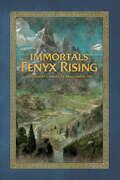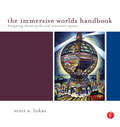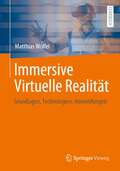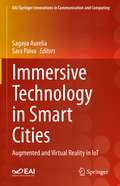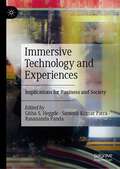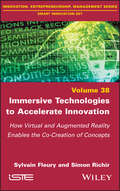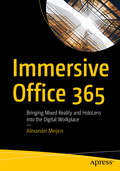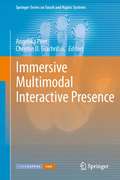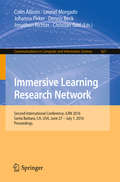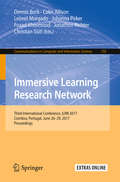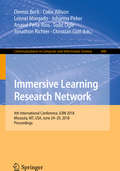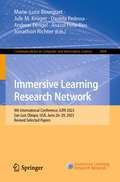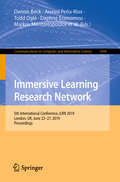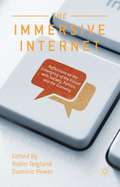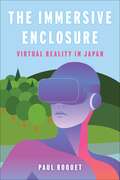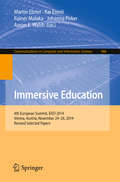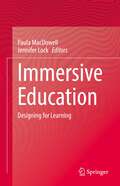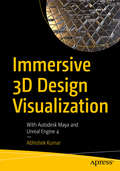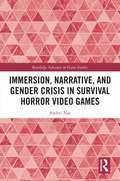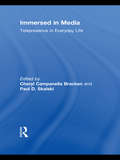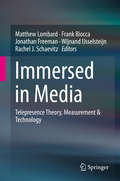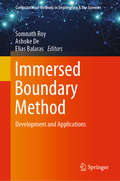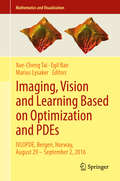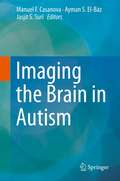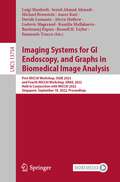- Table View
- List View
Immortals Fenyx Rising: A Traveler's Guide to the Golden Isle
by Rick Barba UbisoftWelcome to Chryse, the Golden Isle! The king of the gods himself, Zeus, presents you with this indispensable travel guide to the ancient Greek island from Ubisoft&’s Immortals Fenyx Rising video game.Follow the king of the gods on an expedition across the different regions of the dazzling island of Chryse: whether strolling through the lush painted gardens of the goddess Aphrodite, battling inside Ares&’s fortress, or planning a boat trip across the river Styx, this full-color travel guide will keep you alive and thriving. In this glorious hardcover, readers will discover all about each region&’s landmarks, secrets and legendary myths and will enjoy Zeus&’s hot goss on the rest of the pantheon! Immortals Fenyx Rising: A Traveler's Guide to the Golden Isle is a must have for any fan of Immortals Fenyx Rising and Greek mythology.
The Immersive Worlds Handbook: Designing Theme Parks and Consumer Spaces
by Scott LukasScott Lukas, famed industry expert on designing themed spaces, brings you a book that focuses on the imaginative world of themed, immersive and consumer spaces. Whether or not you are involved in designing a theme park, cultural museum, shop, or other entertainment space, you will benefit from the insider tips, experiences, and techniques highlighted in this practical guide. Make your themed spaces come to life and become true, immersive worlds. The book features informative sidebars addressing possible design issues and current trends; case studies and interviews with real-world designers, and further reading suggestions. The book also includes a companion website, as well as exercises that accompany each chapter, lavish photos, illustrations, and tables.
Immersive Virtuelle Realität: Grundlagen, Technologien, Anwendungen
by Matthias WölfelVollständig realistische Erfahrungen in einer virtuellen Welt anbieten: Darum geht es bei Immersiver Virtueller Realität. Das ausführliche Lehrbuch bietet Studierenden der Informatik, Medien-, Ingenieur- oder Sozialwissenschaften sowie Medienschaffenden und Anwendern immersiver Umgebungen ein anschauliches Nachschlagewerk zu einschlägigen Lehrveranstaltungen oder zum Selbststudium. Dabei adressiert das Buch alle Aspekte immersiver Medien, die für ein ganzheitliches Verständnis relevant sind: Die ersten Kapitel führen in die theoretischen Grundlagen ein. Diese behandeln die verschiedenen Ausprägungender Realität sowie das Metaversum als Zukunftsvision des Internets, geben einen historischen Überblick, beschreiben relevante Sinne und setzen sich mit Interaktion, Interface und Fortbewegung auseinander. Die darauffolgenden Kapitel veranschaulichen die zugrundeliegenden Technologien wie Sensorik, Tracking und Ausgabetechniken einschließlich Stereoskopie und kopfbezogener Übertragungsfunktion. Der letzte Teil des Buches gibt praxisnahe Einblicke in die unterschiedlichen Anwendungsbereiche: Unterhaltung, soziale Interaktion, Lehren und Lernen, Entwicklung sowie soziologische und medientheoretische Forschung.
Immersive Technology in Smart Cities: Augmented and Virtual Reality in IoT (EAI/Springer Innovations in Communication and Computing)
by Sagaya Aurelia Sara PaivaThis book presents recent trends and enhancements in the convergence of immersive technology and smart cities. The authors discuss various domains such as medical education, construction, brain interface, interactive storytelling, edification, and journalism in relation to combining smart cities, IoT and immersive technologies. The book sets up a medium to promulgate insights and in depth understanding among experts in immersive technologies, IoT, HCI and associated establishments. The book also includes case studies, survey, models, algorithms, frameworks and implementations in storytelling, smart museum, medical education, journalism and more. Various practitioners, academicians and researchers in the domain contribute to the book.
Immersive Technology and Experiences: Implications for Business and Society
by Githa S. Heggde Santosh Kumar Patra Rasananda PandaThis book provides a comprehensive overview of the role of immersive technology with multiple sectoral perspectives, such as entertainment, education, health care, and more. It covers a detailed analysis of the latest trends and developments in the field. It encompasses practical insights on using immersive technology effectively through industry expert chapters, case studies, and real-world examples that demonstrate how immersive technology is being used in different industries. Chapters in this book are from academicians and industry professionals to create a fine balance of knowledge and practice perspective of today’s immersive technology. It is written in accessible language that is easy for non-experts to understand. It focuses on the future of immersive technology, exploring its potential impact on society and the economy. It provides insights into the challenges and opportunities that lie ahead and offers predictions on how immersive technology will continue to evolve in the years to come. It is a valuable resource for anyone learning more about immersive technology.
Immersive Technologies to Accelerate Innovation: How Virtual and Augmented Reality Enables the Co-Creation of Concepts
by Sylvain Fleury Simon RichirThe digital transformation of companies is both a competitive challenge and a complex step for large groups and industries, and at the same time a tremendous opportunity. This transformation is entering a new dimension with the development of immersive technologies such as virtual reality, mixed reality and augmented reality, which are revolutionizing the way we generate content as well as visualize and interact with models and data.The challenges of innovation and digital transformation within companies are now converging. Research shows the potential that immersive technologies have to accelerate the first steps of the innovation process.The objective of this book is to provide a clear vision of the state of research on immersive technologies for design and to deliver practical recommendations for companies wishing to improve their innovation process.
Immersive Office 365: Bringing Mixed Reality and HoloLens into the Digital Workplace
by Alexander MeijersBring mixed reality into your office workplace by building immersive experiences using data and content from your Office 365 platform. Imagine being able to sit at your desk and surround yourself with a 3D chart showing your work relationships as mined from your relationships with others based on how you collaborate together. This book shows you how to access your Office 365 data using the Microsoft Graph API, and then helps you present that data in a 3D modeling visualization using the Microsoft HoloLens 2 as a mixed reality device. This book covers the growing number of tools and techniques you can use to access and visualize data on a Microsoft HoloLens 2 device. Foremost is the Graph API, giving access to the full range of data in Office 365. Also covered are Unity and Visual Studio, the development environments from which you can create mixed reality applications for Microsoft HoloLens 2. You will learn how to load data from and save data to your Office 365 platform based on several interesting use cases. You will be able to extend your digital workplace into a 3D space powered by Microsoft HoloLens 2.Whether you know Office 365 and want to move toward mixed reality, or whether you know the Microsoft HoloLens 2 and want to build functionality around Office 365 data, this book helps you step up and accomplish your goal of bridging between mixed reality and Office 365. What You Will LearnCreate immersive experiences using Microsoft HoloLens 2 and Office 365Access Office 365 data programmatically using the Microsoft Graph APIControl your immersive experiences using natural gestures and eye trackingUnderstand and correctly use different visualization modelsImplement design patterns to write better code in UnityKnow how to access services using web requests via DLLsWho This Book Is ForDevelopers who want to expand their knowledge of the Office 365 platform into the world of mixed reality by creating immersive experiences and 3D visualizations using the Microsoft HoloLens 2 and similar devices, and mixed reality developers who want to extend their repertoire toward serving everyday business needs of workers in corporate office environments
Immersive Multimodal Interactive Presence
by Angelika Peer Christos D. GiachritsisImmersive Multimodal Interactive Presence presents advanced interdisciplinary approaches that connect psychophysical and behavioral haptics research with advances in haptic technology and haptic rendering. It delivers a summary of the results achieved in the IMMERSENCE European project and includes selected chapters by international researchers. Organized into two parts: I. Psychophysical and Behavioral Basis and II. Technology and Rendering, it is an excellent example of interdisciplinary research directed towards the advancement of multimodal immersive virtual environments with particular focus on haptic interaction. The twelve chapters of the book are grouped around three different scenarios representing different types of interactions in virtual environments: Person-Object (PO), Person-Object-Person (POP) and Person-Person (PP) interaction. Recent results of psychophysical and behavioral studies are reported along with new technological developments for haptic displays and novel haptic rendering techniques.
Immersive Learning Research Network
by Colin Allison Leonel Morgado Johanna Pirker Dennis Beck Jonathon Richter Christian GütlThis book constitutes the refereed proceedings of the Second International Conference of the Immersive Learning Network, iLRN 2016, held in Santa Barbara, CA, USA, in June/July 2016. The proceedings contain 9 full papers carefully reviewed and selected from 45 submissions and the best 5 special track papers. The papers focus on various applications of immersive technologies to learning.
Immersive Learning Research Network: Third International Conference, iLRN 2017, Coimbra, Portugal, June 26–29, 2017. Proceedings (Communications in Computer and Information Science #725)
by Dennis Beck Colin Allison Leonel Morgado Johanna Pirker Foaad Khosmood Jonathon Richter Christian GütlThis book constitutes the refereed proceedings of the Second International Conference of the Immersive Learning Network, iLRN 2016, held in Santa Barbara, CA, USA, in June/July 2016. The proceedings contain 9 full papers carefully reviewed and selected from 45 submissions and the best 5 special track papers. The papers focus on various applications of immersive technologies to learning.
Immersive Learning Research Network: 4th International Conference, iLRN 2018, Missoula, MT, USA, June 24-29, 2018, Proceedings (Communications in Computer and Information Science #840)
by Dennis Beck Colin Allison Leonel Morgado Johanna Pirker Anasol Peña-Rios Todd Ogle Jonathon Richter Christian GütlThis volume constitutes the refereed proceedings of the 4th International Conference of the Immersive Learning Network, iLRN 2018, held in Missoula, MT, USA, in June 2018. The 12 revised full papers and the two revised short papers presented in this volume were carefully reviewed and selected from 57 submissions. The papers are organized in topical sections on environmental sciences, climate change, immersive technologies; immersive technologies in cultural heritage; immersive technologies in primary and secondary education; games and game design.
Immersive Learning Research Network: 9th International Conference, iLRN 2023, San Luis Obispo, USA, June 26–29, 2023, Revised Selected Papers (Communications in Computer and Information Science #1904)
by Marie-Luce Bourguet Jule M. Krüger Daniela Pedrosa Andreas Dengel Anasol Peña-Rios Jonathon RichterThis volume constitutes the refereed proceedings of the 9th International Conference of the Immersive Learning Network, iLRN 2023, held in San Luis Obispo, USA, in June 2023 as a hybrid event.The 26 revised full papers and 13 shprt papers presented in this volume were carefully reviewed and selected from 110 submissions. The papers are organized in topical sections on foundations in immersive learning research and theory; assessment and evaluation; galleries, libraries, archives and museums; inclusion, diversity, equity, access, and social justice; STEM education; language, culture and heritage; nature & environmental sciences; workforce development & industry training; self and co-regulated learning with immersive learning environments; special track: immersive learning across Latin America: state of research, use cases and projects.
Immersive Learning Research Network: 5th International Conference, iLRN 2019, London, UK, June 23–27, 2019, Proceedings (Communications in Computer and Information Science #1044)
by Leonel Morgado Johanna Pirker Dennis Beck Jonathon Richter Christian Gütl Anasol Peña-Rios Todd Ogle Daphne Economou Markos Mentzelopoulos Christian Eckhardt Roxane Koitz-Hristov Michael GardnerThis volume constitutes the refereed proceedings of the 5th International Conference of the Immersive Learning Network, iLRN 2019, held in London, UK, in June 2019.The 18 revised full papers and presented in this volume were carefully reviewed and selected from 60 submissions. The papers are organized in topical sections on science, technology, engineering, and mathematics (STEM); disciplinary applications: special education; disciplinary applications: history; pedagogical strategies; immersion and presence.
The Immersive Internet
by Robin Teigland Dominic PowerCollecting short thought pieces by some of the leading thinkers on the emerging 'Immersive Internet', Power and Teigland's book questions what a more immersive and intimate internet - based on social media, augmented reality, virtual worlds, online games, 3D internet and beyond - might mean for society and for each of us.
The Immersive Enclosure: Virtual Reality in Japan
by Paul RoquetAlthough virtual reality promises to immerse a person in another world, its true power lies in its ability to sever a person’s spatial situatedness in this one. This is especially clear in Japan, where the VR headset has been embraced as a way to block off existing social environments and reroute perception into more malleable virtual platforms. Is immersion just another name for enclosure?In this groundbreaking analysis of virtual reality, Paul Roquet uncovers how the technology is reshaping the politics of labor, gender, home, and nation. He examines how VR in Japan diverged from American militarism and techno-utopian visions and became a tool for renegotiating personal space. Individuals turned to the VR headset to immerse themselves in three-dimensional worlds drawn from manga, video games, and genre literature. The Japanese government promised VR-operated robots would enable a new era of remote work, targeting those who could not otherwise leave home. Middle-aged men and corporate brands used VR to reimagine themselves through the virtual bodies of anime-styled teenage girls. At a time when digital platforms continue to encroach on everyday life, The Immersive Enclosure takes a critical look at these attempts to jettison existing social realities and offers a bold new approach for understanding the media environments to come.
Immersive Education
by Martin Ebner Kai Erenli Rainer Malaka Johanna Pirker Aaron E. WalshThis book constitutes the refereed proceedings of the 4th European Immersive Education Summit, EiED 2014, held in Vienna, Austria, in November 2014. The 11 revised full papers presented were carefully reviewed and selected from 30 submissions. The papers are organized in topical sections on innovation and technological advancements in e-learning; immersive and emerging technologies for cultural and digital heritage.
Immersive Education: Designing for Learning
by Paula MacDowell Jennifer LockThis book focuses on designing and being a designer of immersive education. It introduces readers to the human experiences within immersive learning environments and contributes research evidence on the effectiveness of immersive technologies in K-12 and post-secondary contexts. Through the chapters, illustrative contextual examples and vignettes demonstrate immersive learning in real-world educational practice. Readers will be equipped to design engaging and culturally relevant immersive experiences for learning in a post-COVID world.Immersive Education: Designing for Learning brings researchers, designers, and educators together to offer pedagogical strategies and design guidelines. The originality lies in integrating theoretical and practical knowledge to design meaningful immersive experiences, with attention to sustainability, community, and creativity. Valuable insights are provided to support students and teachers as immersive learning designers and storytellers.
Immersive 3D Design Visualization: With Autodesk Maya and Unreal Engine 4
by Abhishek KumarDiscover the methods and techniques required for creating immersive design visualization for industry. This book proposes ways for industry-oriented design visualization from scratch. This includes fundamentals of creative and immersive technology; tools and techniques for architectural visualization; design visualization with Autodesk Maya; PBR integration; and texturing, material design, and integration into UE4 for immersive design visualization. You’ll to dive into design and visualization, from planning to execution. You will start with the basics, such as an introduction to design visualization as well as to the software you will be using. You will next learn to create assets such as virtual worlds and texturing, and integrate them with Unreal Engine 4. Finally, there is a capstone project for you to make your own immersive visualization scene. By the end of the book you’ll be able to create assets for use in industries such as game development, entertainment, architecture, design engineering, and digital education. What You Will Learn Gain the fundamentals of immersive design visualization Master design visualization with Autodesk Maya Study interactive visualization with UE4 Create your immersive design portfolio Who This Book Is For Beginning-intermediate learners from the fields of animation, visual art, and computer graphics as well as design visualization, game technology, and virtual reality integration.
Immersion, Narrative, and Gender Crisis in Survival Horror Video Games (Routledge Advances in Game Studies)
by Andrei NaeThis book investigates the narrativity of some of the most popular survival horror video games and the gender politics implicit in their storyworlds. In a thorough analysis of the genre that draws upon detailed comparisons with the mainstream action genre, Andrei Nae places his analysis firmly within a political and social context. In comparing survival horror games to the dominant game design norms of the action genre, the author differentiates between classical and postclassical survival horror games to show how the former reject the norms of the action genre and deliver a critique of the conservative gender politics of action games, while the latter are more heterogeneous in terms of their game design and, implicitly, gender politics. This book will appeal not only to scholars working in game studies, but also to scholars of horror, gender studies, popular culture, visual arts, genre studies and narratology.
Immersed in Media: Telepresence in Everyday Life (Routledge Communication Series)
by Cheryl Campanella Bracken"Over the next few decades, immersive media could fundamentally change the ways humans engage in entertainment, communication, and social interaction. The current volume takes a step towards understanding this potential paradigm shift, combining insights from pioneers of the field of ‘presence’ with bright young scholars who bring a new perspective." —Jeremy Bailenson, Stanford University, USA "This book provides an indispensable contribution to scholars in communication studies, computer science and psychology interested in the modes of being present in different media, and offers a careful historical and theoretical framework to the state-of-the-art research."—Anna Spagnolli, University of Padova, Italy "Bracken and Skalski have assembled a collection of works from the world’s foremost authorities on telepresence, a topic that has gone understudied for years. Someone has finally assembled a comprehensive volume on the subject. This book is a must not only for those interested in telepresence, but for mass communication scholars of all kinds."—Kenneth A. Lachan, University of Massachusetts, Boston, USA Immersed in Media highlights the increasing significance of telepresence in the media field. With contributions representing diverse disciplines, this volume delves into the topic through considerations of popular media types and their effects on users. Chapters in the work explain how the experience of presence can be affected by media technologies, including television, video games, film, and the Internet. They also discuss how presence experience mediates or moderates commonly studied media effects, such as enjoyment, persuasion, and aggression. These discussions are accompanied by overviews of the current state of presence research and its future. Ultimately, this work establishes the crucial role of telepresence in gaining a complete understanding of the uses and effects of popular media technologies.
Immersed in Media
by Matthew Lombard Frank Biocca Jonathan Freeman Wijnand Ijsselsteijn Rachel J. SchaevitzHighlights key research currently being undertaken within the field of telepresence, providing the most detailed account of the field to date, advancing our understanding of a fundamental property of all media - the illusion of presence; the sense of "being there" inside a virtual environment, with actual or virtual others. This collection has been put together by leading international scholars from America, Europe, and Asia. Together, they describe the state-of-the-art in presence theory, research and technology design for an advanced academic audience. Immersed in Media provides research that can help designers optimize presence for users of advanced media technologies such as virtual and augmented reality, collaborative social media, robotics, and artificial intelligence and lead us to better understand human cognition, emotion and behaviour.
Immersed Boundary Method: Development and Applications (Computational Methods in Engineering & the Sciences)
by Somnath Roy Ashoke De Elias BalarasThis volume presents the emerging applications of immersed boundary (IB) methods in computational mechanics and complex CFD calculations. It discusses formulations of different IB implementations and also demonstrates applications of these methods in a wide range of problems. It will be of special value to researchers and engineers as well as graduate students working on immersed boundary methods, specifically on recent developments and applications. The book can also be used as a supplementary textbook in advanced courses in computational fluid dynamics.
Imaging, Vision and Learning Based on Optimization and PDEs: IVLOPDE, Bergen, Norway, August 29 – September 2, 2016 (Mathematics and Visualization)
by Xue-Cheng Tai Egil Bae Marius LysakerThis volume presents the peer-reviewed proceedings of the international conference Imaging, Vision and Learning Based on Optimization and PDEs (IVLOPDE), held in Bergen, Norway, in August/September 2016. The contributions cover state-of-the-art research on mathematical techniques for image processing, computer vision and machine learning based on optimization and partial differential equations (PDEs). It has become an established paradigm to formulate problems within image processing and computer vision as PDEs, variational problems or finite dimensional optimization problems. This compact yet expressive framework makes it possible to incorporate a range of desired properties of the solutions and to design algorithms based on well-founded mathematical theory. A growing body of research has also approached more general problems within data analysis and machine learning from the same perspective, and demonstrated the advantages over earlier, more established algorithms. This volume will appeal to all mathematicians and computer scientists interested in novel techniques and analytical results for optimization, variational models and PDEs, together with experimental results on applications ranging from early image formation to high-level image and data analysis.
Imaging the Brain in Autism
by Jasjit S. Suri Ayman S. El-Baz Manuel F. CasanovaData compiled by the Center for Disease Control and Prevention indicates an alarming and continuing increase in the prevalence of autism. Despite intensive research during the last few decades, autism remains a behavioral defined syndrome wherein diagnostic criteria lack in construct validity. And, contrary to other conditions like diabetes and hypertension, there are no biomarkers for autism. However, new imaging methods are changing the way we think about autism, bringing us closer to a falsifiable definition for the condition, identifying affected individuals earlier in life, and recognizing different subtypes of autism. The imaging modalities discussed in this book emphasize the power of new technology to uncover important clues about the condition with the hope of developing effective interventions. Imaging the Brain in Autism was created to examine autism from a unique perspective that would emphasize results from different imaging technologies. These techniques show brain abnormalities in a significant percentage of patients, abnormalities that translate into aberrant functioning and significant clinical symptomatology. It is our hope that this newfound understanding will make the field work collaborative and provide a path that minimizes technical impediments.
Imaging Systems for GI Endoscopy, and Graphs in Biomedical Image Analysis: First MICCAI Workshop, ISGIE 2022, and Fourth MICCAI Workshop, GRAIL 2022, Held in Conjunction with MICCAI 2022, Singapore, September 18, 2022, Proceedings (Lecture Notes in Computer Science #13754)
by Luigi Manfredi Seyed-Ahmad Ahmadi Michael Bronstein Anees Kazi Davide Lomanto Alwyn Mathew Ludovic Magerand Kamilia Mullakaeva Bartlomiej Papiez Russell H. Taylor Emanuele TruccoThis book constitutes the refereed proceedings of the first MICCAI Workshop, ISGIE 2022, Imaging Systems for GI Endoscopy, and the Fourth MICCAI Workshop, GRAIL 2022, GRaphs in biomedicAL Image and analysis, held in conjunction with MICCAI 2022, Singapore, September 18, 2022.ISGIE 2022 accepted 6 papers from the 8 submissions received.This workshop focuses on novel scientific contributions to vision systems, imaging algorithms as well as the autonomous system for endorobot for GI endoscopy. This includes lesion and lumen detection, as well as 3D reconstruction of the GI tract and hand-eye coordination. GRAIL 2022 accepted 6 papers from the 10 submissions received. The workshop aims to bring together scientists that use and develop graph-based models for the analysis of biomedical images and to encourage the exploration of graph-based models for difficult clinical problems within a variety of biomedical imaging contexts.
